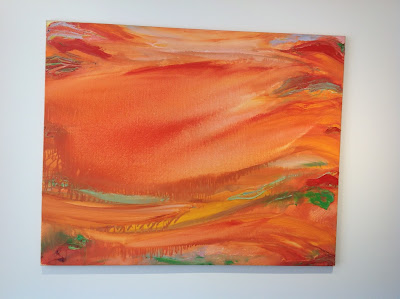I’d been at the
exhibition ‘les Chrétiens d’Orient, deux mille ans d’histoire’ and decided to
walk back from Institut du Monde Arabe along the quai de la Tournelle, Notre
Dame rearing up magnificently solid behind the bare branches of the plane trees
and a leaden sky offering a suitable backdrop for a cold December day.
Once upon a time
I lived on this side of the river and I knew this part of Paris
better: rue de la Clef right beside the Grande Mosquée de Paris and the Jardin
des Plantes. But that was 20 years ago and I don’t often revisit these streets.
Did I ever walk down the rue de la Bièvre? Probably. It’s a shortcut between
the quai and la Place Maubert where there’s a metro station.
Rue de la Bièvre
is a modest, domestic sort of road as this 19th century painting shows.
What you won’t know, unless you are a historian or a lover of old
maps, is that once upon a time there was a canal along it - you can see it in the painting in fact, hence the drying laundry. It took water from
the Bièvre river to the nearby gardens of the abbey of Saint Victor and the street, its name unchanged, features on some of the oldest maps of the city dating back to the
13th century.
The Bièvre is the
second largest river to traverse Paris, although the 21st century
passer-by can have no idea it even exists. It was covered over in 1912 and
remains entirely hidden from our view, another arm of Paris’s underground
drainage and sewage system. But it is a river still and outside the city it
looks like a river.
So to the street
itself – a narrow thoroughfare, with one or two famous residents at one time
and another - Dante for a little while, and more recently François Mitterand
who had his private residence at no. 22 between 1972 and 1995. The little
square halfway along was renamed after his wife in 2013.
 |
| square Danielle Mitterrand |
Another day
another wander through some more unfamiliar Paris streets, this time rue
Jean-Pierre Timbaud, named after the Communist militant and Resistant fighter
one of 26 executed by the Germans on 22 October 1941 after the assassination of
FeldKommandant Karl Hotz in Nantes.
 |
| Jean-Pierre Timbaud |
Rue Jean-Pierre
Timbaud starts very modestly at the end near metro Couronnes on the boulevard
de Belleville and gets progressively more gentrified as you descend it. It
hasn’t entirely lost its radical edge however, having la Maison des Métallos
partway along it, right opposite one of the many mosques in this part of the
city.
This fine
building started out in 1881 as a factory manufacturing the best brass instruments
in the world, selling trumpets and trombones to America’s greatest jazzmen. In
1937 it was taken over by the Union Fraternelle des Métallurgistes, a branch of
the CGT, with a mission to foster ‘social progress’. In this phase of its
existence it was the base for a wide range of left-wing political movements,
supporting the Republicans in the Spanish Civil war, working with the
Resistance, opposing the wars in Algeria and Vietnam and supporting other anti-fascist
campaigns. In 1997 the Union was forced to put the building up for sale. Alarmed at the
idea that this bastion of resistance and social progress might fall into the
hands of private developers, the community came together in a Collecte
Interassociatif and with the support of local councillors got the Mairie de
Paris to buy the building. Which is how in 2007 la maison des Métallos opened
as an établissement culturel de la ville de Paris. It now houses performance
spaces, workshops and a café des Métallos. Well worth a visit if you are in the
neighbourhood.
It seems appropriate to
stay with the musical instrument theme in ending the last bulletin of this difficult year:
the empty manger, the star hidden behind a stifling cloud of CO2 and the heavenly chorus drowned out by the noise of social media.
Some verses therefore, from
a poem for our times.
Learning to Make an Oud in Nazareth
The first day he
cut rosewood for the back,
bent sycamore
into ribs and made a belly
of mahogany. Let us go early to the vineyards
and see
if the vines have budded.
The sky was blue
over the Jezreel valley
and the gilt dove shone
above the Church
of the Annunciation.
The second day,
he carved a camel-bone base
for the fingerboard.
I sat down under his shadow with delight.
…
My beloved is a cluster of camphire
in the vineyards of Engedi
and I watched him whittle an
eagle-feather, a plectrum
to celebrate the angel of improvisation
who dwells in clefts on the Nazareth ridge
where love waits.
And grows, if you give it time.
Set me as a seal upon your heart.
On the sixth day
the soldiers came
For his genetic code.
We have no record
of what happened.
I was queuing at
the checkpoint to Galilee.
I sought him and found him not.
He’d have been at his open-air workshop
–
I
called but he gave me no answer –
The self-same
spot
Where Jesus stood when He came from
Capernaum
to teach in a
synagogue, and townsfolk tried
to throw Him from
the rocks. Until the day break
and
shadows flee away
I will get me to the mountain of myrrh.
The seventh day
we set his wounded hands
Around the
splinters. Come with me from Lebanon,
my
spouse, look from the top
of Shenir and Hermon, from the lions’ dens.
On the eighth day
there were no more days.
I took a class in
carpentry and put away the bridal rug.
We started over
With a child’s
oud bought on eBay.
He was a virtuoso of the oud
and his banner over me was love.
Ruth Padel










































